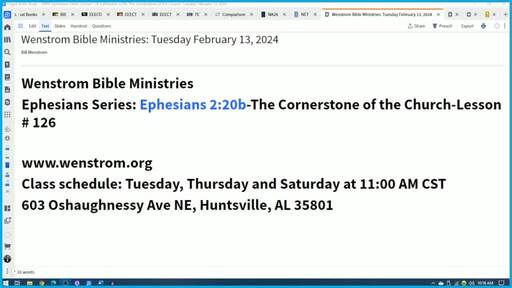Ephesians 2.20b-The Cornerstone of the Church
Wenstrom Bible Ministries
Pastor-Teacher Bill Wenstrom
Tuesday February 13, 2024
Ephesians Series: Ephesians 2:20b-The Cornerstone of the Church
Lesson # 126
Ephesians 2:20 because each and every one of you as a corporate unit have been built upon the foundation, which is the communication of the gospel to each one of you by the apostles as well as prophets. Simultaneously, He Himself, namely, Christ Jesus is the cornerstone. (Lecturer’s translation)
Ephesians 2:20 is composed of the following:
(1) causal participial clause epoikodomēthentes epi tō themeliō tōn apostolōn kai prophētōn (ἐποικοδομηθέντες ἐπὶ τῷ θεμελίῳ τῶν ἀποστόλων καὶ προφητῶν), “because each and every one of you as a corporate unit have been built upon the foundation, which is the communication of the gospel to each one of you by the apostles as well as prophets.”
(2) temporal participial clause ontos akrogōniaiou autou Christou Iēsou (ὄντος ἀκρογωνιαίου αὐτοῦ Χριστοῦ Ἰησοῦ), “Simultaneously, He Himself, namely, Christ Jesus is the cornerstone.”
The causal participle clause presents the reason why the recipients of this epistle, who were Gentile church age believers living in the Roman province of Asia, were fellow citizens with the saints and members of God’s household.
It asserts that it was because they had been built upon the foundation, which is the communication of the gospel to them by the apostles and New Testament prophets, which resulted in the Father declaring them justified as a result of having exercised faith in His Son, Jesus Christ.
The temporal participial clause indicates contemporaneous action with the causal participial clause and asserts that He Himself, the Christ, who is Jesus, is the cornerstone of this building and specifically, temple of God.
Like Ephesians 2:19, Ephesians 2:20-22 contains a metaphor.
In the former, the apostle Paul employs two metaphors to describe Gentile Christians not only in relation to the Jewish Christian community but in relation to every believer in every Old Testament dispensation in the past.
The first metaphor is that Gentile Christians are citizens in a city.
The second is that they are members of a family.
He uses these two metaphors in order to emphatically emphasize that they are share equal status in the kingdom of God with Jewish believers in past Old Testament dispensations and with those believers who lived in the dispensations before the establishment of the nation of Israel.
In other words, Paul is stating in emphatic terms to the Gentile Christian community that they are by no means second rate citizens.
Therefore, we can see that these two metaphors present an emphatic contrast between the unregenerate state of these Gentile church age believers and their present regenerate state as justified sinners who are in union with Jesus Christ and identified with Him in His crucifixion, death, burial, resurrection and session at the right hand of the Father.
Now here in Ephesians 2:20, Paul employs a building metaphor and specifically a temple metaphor in order to describe the church.
Now, the adjective akrogōniaios (ἀκρογωνιαῖος), “cornerstone,” which appears in the temporal participial clause here in Ephesians 2:20 pertains the first stone laid in the construction of a building at the outer corner of two intersecting masonry walls.
Specifically, it refers to the cornerstone of a building.
It is used figuratively of Jesus Christ being the cornerstone of the church.
Specifically, it describes His person, teaching, crucifixion, death, burial, resurrection and session at the right hand of the Father as the cornerstone of the church.
The NET Bible writes “The meaning of ἀκρογωνιαῖος (akrogōniaios) is greatly debated. The meaning ‘capstone’ is proposed by J. Jeremias (TDNT 1:792), but the most important text for this meaning (T. Sol. 22:7–23:4) is late and possibly not even an appropriate parallel. The only place ἀκρογωνιαῖος is used in the LXX is Isa 28:16, and there it clearly refers to a cornerstone that is part of a foundation. Furthermore, the imagery in this context has the building growing off the cornerstone upward, whereas if Christ were the capstone, he would not assume his position until the building was finished, which vv. 21–22 argue against.”
As was the case in Ephesians 1:1, 2, 3, 5, 10, 12, 17, 20, 2:5, 6, 7, 10, 12 and 13, the proper name Christos (Χριστός), “Christ” here in Ephesians 2:20 emphasizes that Jesus of Nazareth, the incarnate Son of God delivered the believer from the sin nature, personal sins, the devil and his cosmic system, spiritual and physical death and eternal condemnation through His substitutionary spiritual and physical deaths and resurrection.
This word Christos (Χριστός) denotes the Messiahship of Jesus of Nazareth; thus He is the Deliverer of the human race in three areas through His death, resurrection, ascension and session: (1) Satan (2) Cosmic System (3) Old Sin Nature.
The Lord’s Messiahship has a four-fold significance: (1) Separation unto God. (2) Authorization from God. (3) Divine enablement. (4) The coming Deliverer.
It also signifies the uniqueness of Jesus of Nazareth who is the God-Man.
Christos (Χριστός) also signifies that Jesus of Nazareth served God the Father exclusively and this was manifested by His execution of the Father’s salvation plan which was accomplished by His voluntary substitutionary spiritual and physical deaths on the cross.
The word signifies that Jesus of Nazareth has been given authority by God the Father to forgive sins, give eternal life, and authority over all creation and every creature as a result of His execution of the Father’s salvation plan.
It denotes that Jesus of Nazareth was perpetually guided and empowered by God the Holy Spirit during His First Advent.
Lastly, it signifies that Jesus of Nazareth is the promised deliverer of the human race from the bondage of Satan, his cosmic system and the old Adamic sin nature.
The proper name Christos (Χριστός) contains the figure of metonymy which means that the Christ is put for His person, teaching, crucifixion, death, burial, resurrection and session at the right hand of the Father.
The genitive masculine singular form of the proper noun Iēsous (Ἰησοῦς), “Jesus” refers to the human nature of the incarnate Son of God, Jesus of Nazareth.
It functions as a genitive of simple apposition which means that it simply clarifies who is Christ here, namely Jesus of Nazareth since there were many in the first century who made the claim.
The verb eimi (εἰμί) is expressing the idea that Jesus Christ’s person, teaching, crucifixion, death, burial, resurrection and session at the right hand of the Father “possesses inherently the characteristic” of being the chief cornerstone of the church.
The participle conjugation of this verb functions as a temporal participle indicating that it is contemporaneous with the action of the aorist tense of the verb epoikodomeō (ἐποικοδομέω).
Therefore, this would express the idea that the church is built upon foundation, which is the Spirit empowered proclamation of the gospel to them when they were unregenerate by the apostles and prophets, “while simultaneously” Jesus Christ’s person, teaching, crucifixion, death, burial, resurrection and session at the right hand of the Father is the chief cornerstone of the church.
The participle conjugation of this verb functions as a genitive absolute which serves to distinguish Jesus Christ from His apostles and prophets by asserting that He is the chief cornerstone of the church.
Specifically, it serves to distinguish Him from His apostles and prophets by emphasizing that His person, teaching, crucifixion, death, burial, resurrection and session at the right hand of the Father is the chief cornerstone of the church.





